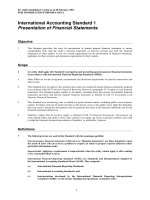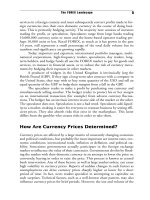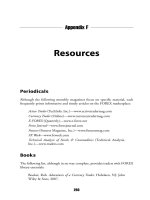Lecture Accounting: What the numbers mean (5/e) - Chapter 5: Accounting for and presentation of current assets
Bạn đang xem bản rút gọn của tài liệu. Xem và tải ngay bản đầy đủ của tài liệu tại đây (169.29 KB, 48 trang )
CHAPTER 5
ACCOUNTING FOR AND
PRESENTATION OF
CURRENT ASSETS
McGrawHill/Irwin
©The McGrawHill Companies, Inc., 2002
Learning Objectives
1. What is included in the cash amount
reported on the balance sheet?
2. What are the features of an internal control
system, and why are internal controls
important?
3. What is the bank reconciliation procedure?
4. How are short-term marketable securities
reported on the balance sheet?
McGrawHill/Irwin
©The McGrawHill Companies, Inc., 2002
Learning Objectives
5. How are accounts receivable reported
on the balance sheet, including the
valuation allowances for estimated
uncollectible accounts and estimated
cash discounts?
6. How are notes receivable and related
accrued interest reported on the
balance sheet?
7. How are inventories reported on the
balance sheet?
McGrawHill/Irwin
©The McGrawHill Companies, Inc., 2002
Learning Objectives
8. What are the alternative inventory
cost flow assumptions, and what are
their respective effects on the income
statement and balance sheet when
price levels are changing?
9. What are the effects of inventory
errors on the balance sheet and
income statement?
10. What are prepaid expenses, and how
are they reported on the balance
sheet?
McGrawHill/Irwin
©The McGrawHill Companies, Inc., 2002
Learning Objective 1
• What is included in the cash
amount reported on the balance
sheet?
McGrawHill/Irwin
©The McGrawHill Companies, Inc., 2002
Cash and Cash Equivalents
• Cash includes money on hand in change
funds, petty cash, undeposited receipts, and
checking and savings accounts
• Cash equivalents are short-term investments
easily convertible to cash
• Cash management is concerned with
maximizing earnings by having as much cash
as feasible invested for the longest possible
time
McGrawHill/Irwin
©The McGrawHill Companies, Inc., 2002
Learning Objective 2
• What are the features of an internal
control system, and why are internal
controls important?
McGrawHill/Irwin
©The McGrawHill Companies, Inc., 2002
Internal Control System
• A process designed to provide
reasonable assurance that objects are achieved
with respect to:
– The effectiveness and efficiency of the operations
– The reliability of the organization’s financial reporting
– The organization’s compliance with applicable laws and
regulations
• Includes financial and administrative controls
McGrawHill/Irwin
©The McGrawHill Companies, Inc., 2002
Financial Controls
• Are related to the concept of separation of
duties
• Includes a system of checks and balances
such that one individual is not involved in an
entire transaction
• Example: individual preparing checks does
not sign the checks
McGrawHill/Irwin
©The McGrawHill Companies, Inc., 2002
Administrative Controls
• Frequently included in policy and
procedures manuals
• Reflected in management reviews of
operations and activities
• Example: evaluating a customer’s credit
history before approving a credit sale
McGrawHill/Irwin
©The McGrawHill Companies, Inc., 2002
Learning Objective 3
• What is the bank reconciliation
procedure?
McGrawHill/Irwin
©The McGrawHill Companies, Inc., 2002
Bank Reconciliation
• Used to determine that the amount of
cash shown in the general ledger is the
same as the cash reported by the bank
• Differences may result due to:
– Timing differences
– Errors
McGrawHill/Irwin
©The McGrawHill Companies, Inc., 2002
Timing Differences
• Deposits in transit – included in firm’s cash
account, but not yet recorded by the bank
• Outstanding checks – deducted from firm’s
cash account, but not yet deducted by the
bank
• Bank service charges – deducted by the
bank, but not yet deducted from firm’s cash
account
• NSF checks – not sufficient funds- checks
that have bounced from a customer’s account
McGrawHill/Irwin
©The McGrawHill Companies, Inc., 2002
Errors
• Can be made by either the firm or the
bank
• If the error is in the recording of cash
transactions on the firm’s books, an
adjusting entry must be made to
correct it
• Often a very time-consuming process
to find errors
McGrawHill/Irwin
©The McGrawHill Companies, Inc., 2002
Bank Reconciliation Example
Bank Records
Indicated balance
$5,233.21
Add: Deposits in transit
859.10
Less: Outstanding checks (1,526.58)
Reconciled balance
$4,565.73
=============
Company Books
Indicated balance
Add: Interest earned
Less: Service charge
NSF Check
Reconciled balance
$4,614.58
28.91
(43.76)
(35.00)
$4,565.73
============
McGrawHill/Irwin
©The McGrawHill Companies, Inc., 2002
Learning Objective 4
• How are short-term marketable
securities reported on the balance
sheet?
McGrawHill/Irwin
©The McGrawHill Companies, Inc., 2002
Short-Term Marketable
Securities
• Part of a firm’s cash management strategy
• Prudent use of short-term marketable
securities as investments can improve ROI
• Examples: U.S. treasury securities,
commercial paper, and bank certificates of
deposit
McGrawHill/Irwin
©The McGrawHill Companies, Inc., 2002
Reporting of Short-Term
Marketable Securities
• Short-term marketable debt securities that are
classified as held-to-maturity are reported at
cost
• Debt and equity securities that are classified
as trading or available-for-sale securities are
reported at market value
• Interest on these securities is accrued as it is
earned
McGrawHill/Irwin
©The McGrawHill Companies, Inc., 2002
Learning Objective 5
• How are accounts receivable reported on
the balance sheet, including the
valuation allowances for estimated
uncollectible accounts and estimated
cash discounts?
McGrawHill/Irwin
©The McGrawHill Companies, Inc., 2002
Accounts Receivable
• Are reported on the Balance Sheet at
net realizable value – the amount
expected to be received from
customers
• The amount initially recorded may be
different from net realizable due to:
– Bad debts
– Cash discounts
McGrawHill/Irwin
©The McGrawHill Companies, Inc., 2002
Bad Debts
• Bad debts are inevitable when sales are made
on credit
• Credit managers are able to estimate the
amount of bad debts fairly accurately
• Two methods are used to estimate bad debts:
– Percentage of credit sales
– Aging of accounts receivable
McGrawHill/Irwin
©The McGrawHill Companies, Inc., 2002
Percentage of Credit Sales
• An estimated percentage of credit sales
losses is multiplied by the total credit
sales
• An entry is made in the firm’s records
increasing bad debt expense and
increasing a valuation adjustment
account
McGrawHill/Irwin
©The McGrawHill Companies, Inc., 2002
Aging of Accounts Receivable
• Involves a detailed analysis of age of accounts
receivable
• The longer an account is past due, the less
likely the firm is to collect the amount owed
• An entry is made in the firm’s records
increasing bad debt expense and
increasing a valuation adjustment
account
McGrawHill/Irwin
©The McGrawHill Companies, Inc., 2002
Entries Related to Bad Debts
• Recording the estimated amount:
Bad Debt Expense
Allowance for Bad Debts
XX
XX
• Writing off an uncollectible account:
Allowance for Bad Debts
Accounts Receivable
McGrawHill/Irwin
XX
XX
©The McGrawHill Companies, Inc., 2002
Cash Discounts
• Are used to encourage prompt payment
• Credit terms often abbreviated as 2/10,
n30, meaning a 2 percent discount may be
taken if the account is paid within 10 days,
and the net amount is due in 30 days
• The estimation of cash discounts is similar
to the estimation of bad debts
McGrawHill/Irwin
©The McGrawHill Companies, Inc., 2002









